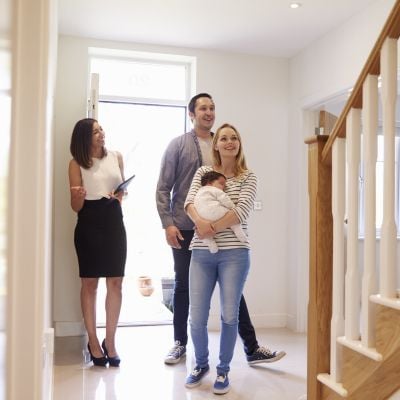Just what is the trigger rate anyway?
The trigger rate applies to variable-rate mortgage holders that are on a fixed payment schedule, and it allows your lender — when the mortgage rate increases to a specified threshold -- to increase your previously fixed monthly mortgage payment, among other measures.
The reason variable-rate mortgages have trigger rates is to ensure that homeowners’ amortization does not extend so much that their payments no longer go toward the principal. In turn, homeowners could see what they owe on their home increase, eventually resulting in a negative equity situation, where they owe more than the actual value of the home.
Under normal circumstances, a portion of the fixed monthly payment on a variable-rate mortgage will go toward interest costs while the remainder toward the principal. Yet, as rates increase, more of your monthly payment goes toward interest and less toward principal.
Most lenders — Canada largest banks, for example — offer variable-rate mortgages where the payments are fixed. A lesser number of lenders — monoline lenders, aka: mortgage-only lenders — typically offer only adjustable-rate variable mortgages. The monthly payments adjust with every increase or decrease in the prime lending rate, which rises and falls with the Bank of Canada overnight rate. Adjustable-rate mortgages — like fixed-rate mortgages — have no trigger rates, given mortgage-holders are already making higher payments as interest rates rise.
Each lender uses a different formula to calculate the trigger rate. However, most trigger rates are set in motion when a large proportion of a monthly mortgage payment goes toward paying the interest costs (with little left to paydown the mortgage debt), or the monthly mortgage payment is insufficiently low and cannot pay all the interest that now accumulates on the mortgage debt (based on the new variable-rate).
Consider this example: Let’s say you bought a home in January 2022 for $625,000 with a 20% down payment of $125,000. Your total mortgage loan would be $500,000. If you negotiated a variable-rate mortgage at 1.5%, then your payments on a five-year term using a 25-year amortization schedule would be just under $2,000 per month. At the start of your loan, approximately $1,400 of your loan payment goes towards paying down the mortgage debt, while the remaining $600 pays the accrued interest.
But what happens when interest rates increase?
The Bank of Canada began to raise the overnight target rate in 2022 and didn’t stop until mid-2023. During this time, you would continue to pay about $2,000 per month as your mortgage payment, but a smaller portion of this payment is used to pay down your mortgage loan. Why? Because variable rates will rise and fall based on market conditions. As the prime rate increases, so does the interest rate on your variable–rate mortgage.
A rate increase of just 0.25% wouldn’t alter your monthly payment of $2,000, but a larger portion of this payment would be used to pay off the accrued interest — about $725 — with the remaining sum used to pay down the mortgage debt (in this example, $1,275).
A slight increase in interest rates won’t impact your monthly mortgage by much, but bigger increases can have a massive impact on the cost of the mortgage both in the short-term and over time.
In all mortgage (and loan) contracts, the lender will set a trigger rate: A rate that prompts the immediate cancellation of the original payment schedule — and the fixed monthly sum you agreed to pay — and forces you to pay a new, higher monthly mortgage payment.
The rationale behind a trigger rate is that mortgage payments should never cover just the interest on the loan. Every mortgage payment should also help to reduce the overall debt and create equity for the homeowner.
How much home can you afford?
Whether you're hunting for a new home or looking to refinance your mortgage, knowing how much your new loan might cost you is critical. Use our handy mortgage calculator to help you understand what your payments could look like.
Get StartedHow your trigger rate works
Every homeowner with a variable-rate mortgage will have a different trigger rate since it’s based on your mortgage amount, monthly payment and interest rate.
The quickest way to determine your trigger rate is to review your mortgage documents. This would be the initial contract you signed. Your trigger rate will be clearly displayed, so you’ll know when to expect a call from your bank. That said, the trigger rate outlined in your documents assumes you haven’t made any prepayments. Every time you make a prepayment, it gets applied directly to your principal, so your trigger rate would increase.
For a more accurate number, you could contact your mortgage lender. They’ll be able to calculate your current trigger rate, so you’ll know how much breathing room you have.
In general, though, the trigger rate can be calculated with the following formula:
- (Monthly payment amount) X (# of payments per year / balance owing) X 100 = Trigger rate in %
For example, if you have an outstanding mortgage balance of $500,000 with monthly payments (12 payments per year) of $1,998.59. Your formula would look like: ($1,998.59 X 12 / $500,000) X 100 = 4.80%
In this scenario, your trigger rate would be about 4.80%. That said, it would likely be slightly higher, given you have made some payments toward the principal before that point. Remember that every lender uses a different formula to calculate your trigger rate, so you’ll want to contact them if you want an exact number. Yet this formula is a reliable way to estimate yours quickly.
What happens when you hit your trigger rate?
When you reach your trigger rate, your lender will contact you with a few different options so you don’t have negative equity with your payments. Generally, you’ll have the following choices available:
- Adjust your payment - Your payment will need to be changed, so at least some of it is going toward your principal. For example, if you were on a 20-year amortization schedule when you hit your trigger rate, your financial institution may advise switching to a 25-year amortization. This is a good option for those who already have equity in their home. If you’re already at the maximum amortization allowed, the lender would need to increase your monthly payment.
- Make a prepayment - The trigger is dependent on the remaining balance of your mortgage. If you make a lump-sum payment, that will push your trigger rate higher. That said, your mortgage likely has specific rules about how many additional payments you can make.
- Switch to a fixed-rate mortgage - Your lender may allow you to switch to a fixed-rate mortgage without penalties. By doing this, you’ll lock in at current rates. While this strategy may give you peace of mind, it could cost you more in the long run. Plus, your monthly payments will likely increase.
- Pay off your mortgage - One final option to avoid your trigger rate is to pay off your mortgage balance. Of course, if you’re worried about your trigger rate, the odds are you don’t have enough cash lying around to discharge your mortgage.
Unexpected vet bills don’t have to break the bank
Life with pets is unpredictable, but there are ways to prepare for the unexpected.
Fetch Insurance offers coverage for treatment of accidents, illnesses, prescriptions drugs, emergency care and more.
Plus, their optional wellness plan covers things like routine vet trips, grooming and training costs, if you want to give your pet the all-star treatment while you protect your bank account.
Get A QuoteBottom line
If you’re concerned about your trigger rate, talk to your lender now about your options. Alternatively, you may need to make some lifestyle changes. Cutting expenses or putting off major expenses could help your cash flow.
Those with small mortgages won’t be as impacted by increasing interest rates since they have equity built up in their homes. It’s new homeowners who have stretched themselves out to get into the market that will feel the pressure.
— with files from Barry Choi and Romana King
You're 5 minutes away from the best mortgage
Searching for your perfect mortgage shouldn’t be hard. Homewise is an online brokerage that will negotiate on your behalf with more than 30 big banks and other lenders, completely free, and it only takes five minutes to apply.
If you're in the market for a new mortgage, or if you're looking to refinance before interest rates rise again, go to Homewise now and answer a few simple questions to get started.









